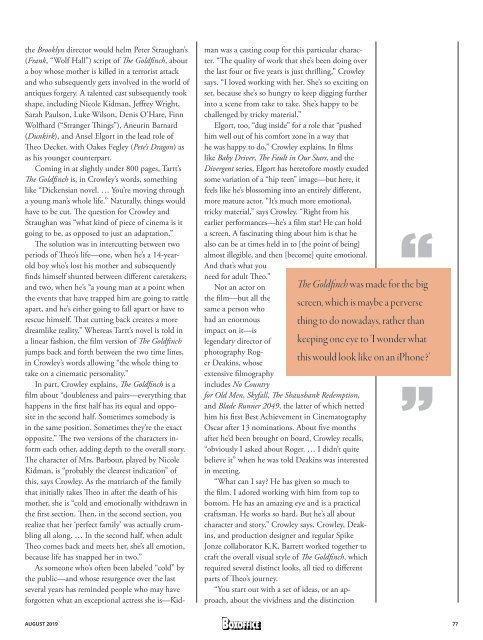Boxoffice - August 2019
The Official Magazine of the National Association of Theatre Owners
The Official Magazine of the National Association of Theatre Owners
Create successful ePaper yourself
Turn your PDF publications into a flip-book with our unique Google optimized e-Paper software.
the Brooklyn director would helm Peter Straughan’s<br />
(Frank, “Wolf Hall”) script of The Goldfinch, about<br />
a boy whose mother is killed in a terrorist attack<br />
and who subsequently gets involved in the world of<br />
antiques forgery. A talented cast subsequently took<br />
shape, including Nicole Kidman, Jeffrey Wright,<br />
Sarah Paulson, Luke Wilson, Denis O’Hare, Finn<br />
Wolfhard (“Stranger Things”), Aneurin Barnard<br />
(Dunkirk), and Ansel Elgort in the lead role of<br />
Theo Decker, with Oakes Fegley (Pete’s Dragon) as<br />
as his younger counterpart.<br />
Coming in at slightly under 800 pages, Tartt’s<br />
The Goldfinch is, in Crowley’s words, something<br />
like “Dickensian novel. … You’re moving through<br />
a young man’s whole life.” Naturally, things would<br />
have to be cut. The question for Crowley and<br />
Straughan was “what kind of piece of cinema is it<br />
going to be, as opposed to just an adaptation.”<br />
The solution was in intercutting between two<br />
periods of Theo’s life—one, when he’s a 14-yearold<br />
boy who’s lost his mother and subsequently<br />
finds himself shunted between different caretakers;<br />
and two, when he’s “a young man at a point when<br />
the events that have trapped him are going to rattle<br />
apart, and he’s either going to fall apart or have to<br />
rescue himself. That cutting back creates a more<br />
dreamlike reality.” Whereas Tartt’s novel is told in<br />
a linear fashion, the film version of The Goldfinch<br />
jumps back and forth between the two time lines,<br />
in Crowley’s words allowing “the whole thing to<br />
take on a cinematic personality.”<br />
In part, Crowley explains, The Goldfinch is a<br />
film about “doubleness and pairs—everything that<br />
happens in the first half has its equal and opposite<br />
in the second half. Sometimes somebody is<br />
in the same position. Sometimes they’re the exact<br />
opposite.” The two versions of the characters inform<br />
each other, adding depth to the overall story.<br />
The character of Mrs. Barbour, played by Nicole<br />
Kidman, is “probably the clearest indication” of<br />
this, says Crowley. As the matriarch of the family<br />
that initially takes Theo in after the death of his<br />
mother, she is “cold and emotionally withdrawn in<br />
the first section. Then, in the second section, you<br />
realize that her ‘perfect family’ was actually crumbling<br />
all along. … In the second half, when adult<br />
Theo comes back and meets her, she’s all emotion,<br />
because life has snapped her in two.”<br />
As someone who’s often been labeled “cold” by<br />
the public—and whose resurgence over the last<br />
several years has reminded people who may have<br />
forgotten what an exceptional actress she is—Kidman<br />
was a casting coup for this particular character.<br />
“The quality of work that she’s been doing over<br />
the last four or five years is just thrilling,” Crowley<br />
says. “I loved working with her. She’s so exciting on<br />
set, because she’s so hungry to keep digging further<br />
into a scene from take to take. She’s happy to be<br />
challenged by tricky material.”<br />
Elgort, too, “dug inside” for a role that “pushed<br />
him well out of his comfort zone in a way that<br />
he was happy to do,” Crowley explains. In films<br />
like Baby Driver, The Fault in Our Stars, and the<br />
Divergent series, Elgort has heretofore mostly exuded<br />
some variation of a “hip teen” image—but here, it<br />
feels like he’s blossoming into an entirely different,<br />
more mature actor. “It’s much more emotional,<br />
tricky material,” says Crowley. “Right from his<br />
earlier performances—he’s a film star! He can hold<br />
a screen. A fascinating thing about him is that he<br />
also can be at times held in to [the point of being]<br />
almost illegible, and then [become] quite emotional.<br />
And that’s what you<br />
need for adult Theo.”<br />
Not an actor on<br />
the film—but all the<br />
same a person who<br />
had an enormous<br />
impact on it—is<br />
legendary director of<br />
photography Roger<br />
Deakins, whose<br />
extensive filmography<br />
includes No Country<br />
for Old Men, Skyfall, The Shawshank Redemption,<br />
and Blade Runner 2049, the latter of which netted<br />
him his first Best Achievement in Cinematography<br />
Oscar after 13 nominations. About five months<br />
after he’d been brought on board, Crowley recalls,<br />
“obviously I asked about Roger. … I didn’t quite<br />
believe it” when he was told Deakins was interested<br />
in meeting.<br />
“What can I say? He has given so much to<br />
the film. I adored working with him from top to<br />
bottom. He has an amazing eye and is a practical<br />
craftsman. He works so hard. But he’s all about<br />
character and story,” Crowley says. Crowley, Deakins,<br />
and production designer and regular Spike<br />
Jonze collaborator K.K. Barrett worked together to<br />
craft the overall visual style of The Goldfinch, which<br />
required several distinct looks, all tied to different<br />
parts of Theo’s journey.<br />
“You start out with a set of ideas, or an approach,<br />
about the vividness and the distinction<br />
The Goldfinch was made for the big<br />
screen, which is maybe a perverse<br />
thing to do nowadays, rather than<br />
keeping one eye to ‘I wonder what<br />
this would look like on an iPhone?’<br />
AUGUST <strong>2019</strong><br />
77

















